Page 3
Planting a Few Trees
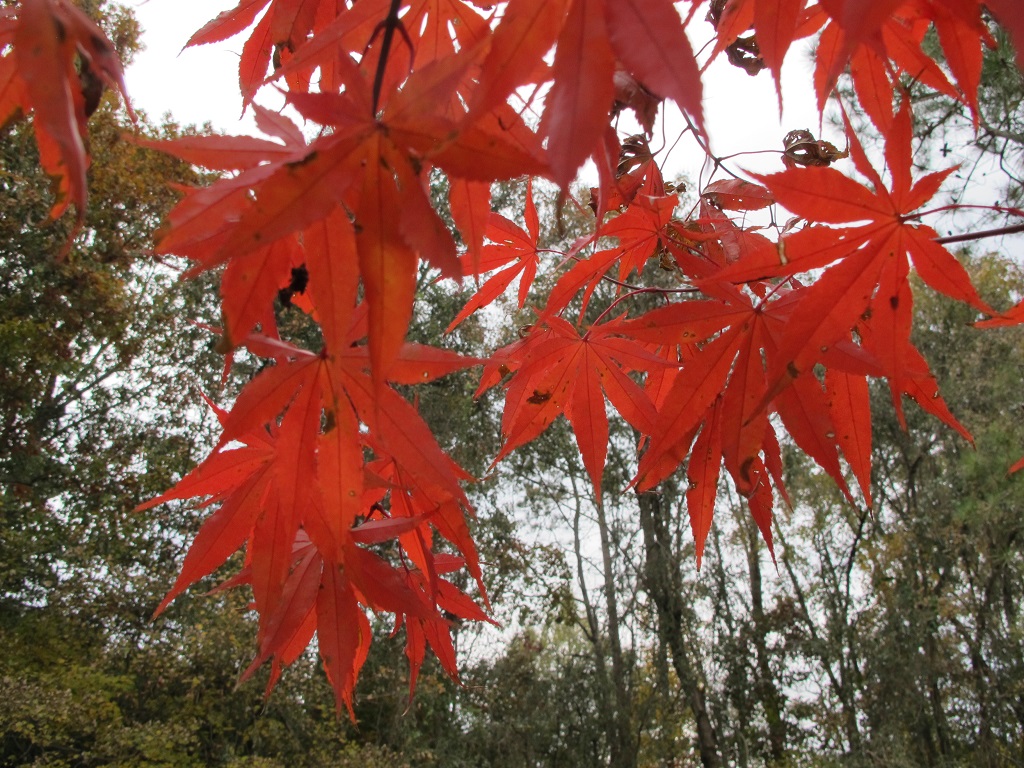
The Japanese maple in fall color, 2020.
Looking out from the windows is a good way to locate potential places for trees. Observing from the street also helps determine a good location relative to existing vegetation and the house.
Since I didn’t want to obstruct the open view from the east-facing kitchen windows, I planted a large dogwood and a Japanese maple (an Acer palmatum volunteer) at opposite edges of the field of vision. They’re over 100′ apart and barely visible from the 2 kitchen windows now, but they’ll grow. I’ll still be able to enjoy those wonderful sunrises.
From my office, on the other side of the house, I can see the crape myrtle (Lagerstroemia indica) out the left side of the window. It’s planted well inside a curve of the driveway. This multi-stemmed tree blooms for a few months, adding thousands of light pink flowers to a view with no existing color other than gray, green, and the fire hydrant’s red. Since it grew from a seed, I don’t know how tall it will grow. The space, however, will accommodate a tree that matures at 10′ or at 25′.
The variegated dogwood, with white-margined leaves, is planted on the steep slope near the western end of the back deck. It will provide shade on a hot summer afternoon, and the hostas’ root systems bind the soil, preventing erosion (later, I moved the hostas).
The Rule of Thirds
All 4 of these trees are the anchors, or the main characters, in beds that have just been started. I’ll plant more shrubs, ground covers, bulbs, and flowering annuals and perennials—the supporting characters—around the anchors.
Those trees will end up about one-third of the way into the bed instead of in dead center. The “Rule of Thirds” applies to any project where proportion and aesthetics have a role.
Avoid planting a tree in the center of the yard or a garden. Planting a specimen tree or a large shrub right in the center of a view bisects that view, resulting in a less satisfying picture. If possible, shift the tree to one-third of the way into the bed, and plant clusters of shorter species with it. Except for par-terres, which embrace geometry, your garden will look more natural and restful when employing this simple design axiom.
Ultimately, though, it comes down to your own personal style and the constraints of the site.
Too Cold to Plant New Gardens?
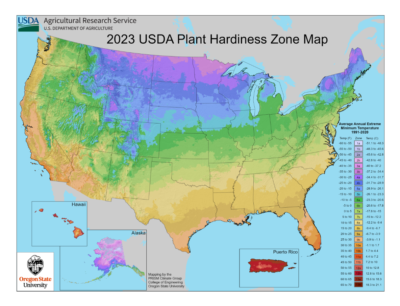
Most hardy trees, shrubs, and perennials can be planted well into the fall and early winter in this USDA zone 7b region. Where sunlight falls on the ground or on south-facing slopes, soil freezes later than it does in shady areas or on north-facing slopes.
Here, frost settles most nights on top of vegetation, but the soil has not yet frozen. When it does, it rarely freezes below an inch and often thaws by noon. (***Update***: In fact, we’ve enjoyed a very warm season, and on Christmas day, 2021, it reached 70° F, about 20° above average. The ground never froze. 2/25/2022)
Hardy plants continue rooting out until the soil temperature drops below 40° F. Once the soil freezes, though, the planting season is over for most of us.
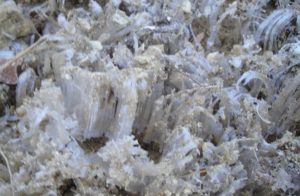
Ice crystals rise 2″ from freezing ground, near Crab Orchard Falls NC.
The plants I’ve been tending all these years would much rather settle into their new homes than spend one more winter in those pots. I believe that any hardy plant in a pot would prefer to be safely tucked into the ground. With proper soil preparation and maintenance, fall- and winter-planted trees should do fine.
Pay close attention to watering new additions to the garden. Water expands as it freezes, and ice can push a small plant’s root ball above the soil surface, causing it to dry out. When frost heaving occurs, settle the plant back into the soil and water it in. Mulch or a thick pile of leaves will give the plant more time to secure itself to the ground. If necessary, place a rock or two on the root ball to hold it down.
Viola
Chilly autumn temperatures won’t bother the little violas and pansies. These hardy biennials add cheerful color when nothing else is blooming outside. I favor the violas because they tolerate colder temperatures than pansies, to USDA hardiness zone 4 or 5. For this season, I planted several into a shallow ceramic pot, kept on the sunny front porch. Their flowers are edible, so they’ll add a spot of color to a winter salad.
- Violas planted in a ceramic pot for the winter.
- Viola and a seedpod that has split open.
Different Players—Same Script
The method used to plant each of the trees was the same. I normally recommend using pine fines and coarse sand to improve drainage. Incorporating coarse materials into the soil increases the air pore space, allowing air, water, and roots to more easily find their way through the soil profile.
There’s a whole forest full of composted topsoil and leaf mold, so I decided to save the expense of purchasing amendments and used existing materials already on the property. The woods won’t miss them. For some plants, I supplemented the backfill with potting soil that had been used for potted tomatoes and annuals.
However, I did buy a large bale of peat moss and used some for each of the plants, and more for the blueberry, which needs very acidic soil. Also, as the new gardens expand, I’ll bring in pine fines and other amendments to build up the soil. The blueberry will be joined by other varieties for cross-pollination. And there’s room for a few fruit trees, including edible figs.
The topsoil isn’t great, but it’s not too bad. In some places, there’s a good 6″ of decent soil. Under that is a layer of clay, and in some parts of the yard, a layer of really awful hardened clay called hardpan. I broke up the hardpan and built up the soil using the good topsoil and leaf mold from the woods.
Applying gypsum once or twice a year for several years will flocculate tiny clay particles into larger clay particles, opening up minute channels (air pore space) through the soil profile. Drainage will improve over the years, giving the soil better tilth. Gypsum is calcium sulfate, and it supplies calcium and sulfur without altering the soil pH.
Earthworms play an important part in opening up the soil and depositing enriched castings and beneficial microbes as they burrow through the ground. Where there’s organic matter and moisture in the soil, earthworms will appear. After collecting a potful of kitchen scraps (all vegetable matter and eggshells), I’ll incorporate it into the next planting hole. To earthworms, that’s like ringing the dinner bell. During the growing season, the softer scraps disappear in less than 2 weeks.
All Those Leaves
There’s an almost inexhaustible supply of fallen oak leaves. Once the soil had been improved right next to the transplanted trees’ roots, I mixed a large quantity of mower-chopped leaves into the backfill. The leaves were not in direct contact with the roots, avoiding the possibility of microbes taking nitrogen out of the soil away from the roots.
Rich soil from the woods incorporated among the leaves adds trillions of microbes. They’ll decompose the debris while the soil stays warm and resume their work in spring. At that time, I’ll apply a small amount of nitrogen-based fertilizer to make up for the nitrogen that microbes “steal” when they begin decomposing organic materials. Microbes are largely dormant in cold soil.
Mycorrhizae form an expansive structure, called a mycelium, through a forest’s leaf litter. These fungal microbes, when established, form a mutualistic association in or around a plant’s roots. They can provide plants with water, minerals, and some degree of protection from pathogens while taking carbohydrates in return. As researchers discover how mycorrhizae contribute to the health of an ecosystem, we gain insight into practices that improve our success as gardeners and caretakers of the environment.
After the new tree had been tucked into the ground, I added a thick layer of oak leaves over the root ball extending several feet out in each direction. This will kill more of the grass than I excavated…all part of the plan. I do not cut back or remove any branches on new trees unless they’re damaged or awkwardly positioned.
Wind can blow away the leaves, so I laid twigs on top of them. Those are the same twigs that have been falling from the trees, with branches collected from the woods or the old wood pile. A bucketful of compost from the woods and clumps of sod I had set aside hold the leaves and twigs in place. This practice is acceptable in rural areas, but neighbors living nearby and HOA’s might express concern.

The Japanese maple and leaves held in place with logs.
A Welcome Surprise
Before doing major plantings near the house, I’ll heed my own advice: wait and see what the grounds offer. The weather has been gorgeous. Although many more boxes need to be unpacked, it’s hard to stay indoors when it’s sunny and in the 60’s or 70’s F in November and December. Forget it; I’m going outside to play!
In several areas, grape hyacinths have grown fall foliage, so there might be other bulbs resting underground. A few days after moving in, I noticed small clusters of short flowers near a tree stump. From the kitchen window, they looked like pale lavender fall crocuses, barely taller than the grass around them. But the flowers are gone now. Since I didn’t mark their locations, I won’t dig that area until I find them.
Whether they’re crocuses or some other minor bulb, they were nevertheless unexpected. And I do want to save them. My brother and I might have trampled them as we focused his telescope on the incredible Milky Way…in the dark. (***Update***: The fall crocuses return each autumn.)
A large stretch of mondo grass (Ophiopogon sp.) covers the ground under the trees near mature boxwoods (Buxus sempervirens), varieties unknown. In the spring, I’ll transplant plugs of this short grassy evergreen to shady areas. I first noticed it last week while raking leaves. (***Update***: The mondo grass sends up sort spikes of pale lilac flowers through August. There are a few large patches of them; fertilizing them last year resulted in thicker growth and more flowers. Small, but lovely! 8/2024)
A few young evergreen hollies (Ilex opaca) peer out from under the boxwoods. Birds probably deposited the seeds of this native holly. I’ll transplant them to the other side of the big brush pile, where they’ll tolerate dappled shade from the oaks.
Little surprises, but welcome ones.
A Firm Foundation
Rainwater has been flowing toward the foundation, causing leaks in the basement. Nothing major, but this must be fixed.
When digging holes for the trees and other plants, I removed and saved much of the thick red clay. Then I shoveled out the dark topsoil next to the foundation and added it to the backfill. And the heavy clay went next to the house where the topsoil used to be.
Packed against the foundation and rising higher than the surrounding lawn, the 12″ layer of compacted clay should divert most water away from the house. Tiny clay particles pack together so tightly that water percolates very slowly, before it can soak in and seep through the foundation.
Except for a recent shower, we haven’t had a good rain for weeks. Until plants root out into the soil, the existing dry clay sucks all the moisture out of the transplants’ potting soil. Although they’re leafless, the transplants still need water every 2-3 days to keep the roots reasonably moist and alive. After the next few showers, and once cold weather is here to stay, plants probably won’t need water.
Last month, I had municipal water brought into the house. I kept the well hooked up to the outdoor faucets for an almost free supply of water when needed for the gardens.
It’s time-consuming, but I’ll dig a more substantial swale around the house to carry surface runoff to the woods or down to the new gardens. Improving the slope next to the house is a priority. Preliminary digging close to the east side of the house revealed a large volume of rounded rocks, presumably installed years ago for “drainage”. Instead of helping water drain away from the house, rocks attract water close to the house…hence, a wet basement after moderate rainfall.
I spotted several cracks between the foundation blocks, not uncommon for a house this age. The cracks and the swale should be addressed before planting anything close to the house.
First Snow
***Update***: The ground is soaked from heavy rains, and this morning, for 2 delightful hours, we had a lovely wet snow. It was 80° just a couple of days ago. 1/3/2022
Heeling In
Hardy plants in pots not planted soon will be heeled in. Heeling in is a method to quickly but temporarily settle the plants in for the winter.
I’ll plant the pots into the ground, almost to the rim. Soil around the pots insulates roots from temperature extremes, and a layer of leaves holds some warmth and moisture in the soil. Even in cold weather, these plants, particularly the evergreens, will need water now and then.
Iris
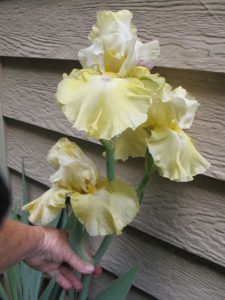
A reblooming and fragrant iris called ‘Again and Again’.
The dozen or so potted bearded irises (Iris x germanica), can be planted now. My father grew the blue and purple ones many years ago. I also have a few different irises from plants purchased in Maryland. But if I delay much longer, I’ll heel in these plants as well (no mulch).
A good spot for these sword-leaved perennials might be on a small rise at the far end of the driveway. Here, crushed limestone from the driveway has mixed with the soil, and it’s in full sun. I’ll plant another bed of irises on the south side of the crape myrtle nearby.
Bearded irises do not enjoy the same moist, rich compost that ferns and astilbes like. They prefer a somewhat leaner soil and must have excellent drainage. Their rhizomes should be planted very close to the soil surface, and not mulched.
I’ll reserve the spectacular reblooming irises for new gardens planned for the front of the house, where they can be seen from the porch. That area lends itself to the English cottage garden style, picket fence and all.
I’ve already started the cottage garden, planting a Chamaecyparis ‘Vintage Gold’, the Itoh peony plus one division, and a rust-colored chrysanthemeum from last year. No fence yet, though. (***Update***: Yesterday, I added ‘Again and Again’ and ‘Masai Warrior’ irises, near the chamaecyparis, and clusters of spring-flowering bulbs from pots. 12/17/21)
Chores Indoors
Conserving resources to lower energy bills makes sense as costs have risen quickly over the past year. I caulked all those little cracks and shut out the wintry chill. A caulking gun and a few tubes of high-quality paintable caulk are an inexpensive solution. An old blanket and pipe insulation keep the water heater warmer in the basement.
Two packages of weather stripping for the doors, and daylight no longer slips through. The latches, though, had to be moved a fraction of an inch for the doors to close easily.
During this splendid weather, I’ve been placing 10 bins of dwarf succulents (photo, below) on the sunny porch and returning them indoors every day. It’s getting a little old, indicating the need for light tables in the basement. These warm temperatures will not last, so that’s my next project, and, ultimately…the greenhouse.
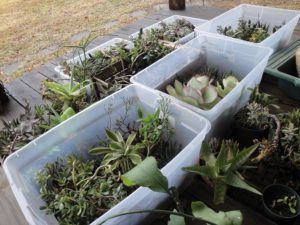
Christmas Already?
Great gifts for the gardeners in your life could include well-made tools, such as a sturdy garden fork, Felco pruners, a spade and a shovel, or a simple rugged trowel or pruning saw. Maybe a few packets of seeds, a fresh bottle of Bt, and a bag of earthworm castings. Reference books, a gardening magazine subscription, a DIY greenhouse kit!
After finding the boxes marked “Christmas”, I hung several strings of miniature lights on the front porch. The evergreen magnolia and the boxwood supplied fresh greens, fashioned into large swags for the 2 main posts on the porch and for a centerpiece indoors. Before assembling the greens, I sprayed them with WiltPruf, an antidesiccant. This product forms a clear, waxy layer on leaves and helps conserve moisture.
All the supplies needed to decorate the porch had been packed away 8 years ago, before moving to North Carolina. I was so pleased to find them, the ornaments, and all those pots tucked away in the storage container. Plenty of pots—clay, cell packs, plastic, peat, ceramic, and some handmade—to get the horticulture business up and running once again.
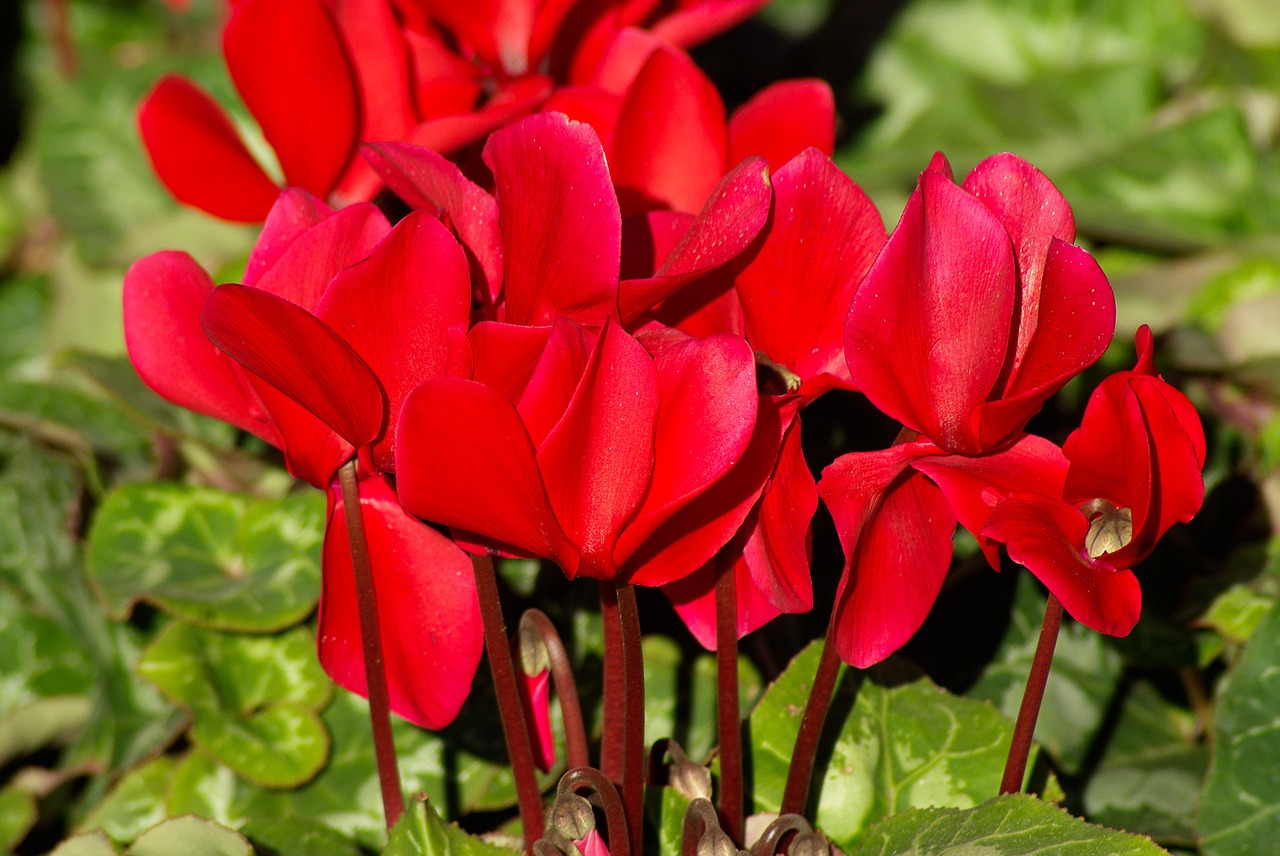
Cyclamen can bloom for months.
Concluding
It’s exciting to see the potential for new gardens this property offers, and I’m grateful to be here and for my brothers’ help moving. Future posts will include articles documenting changes to the landscape. I’ll plant a few more shrubs and perennials before the surface freezes, and then concentrate on preparing for the new growing season. The first day of winter is only a week away!
“Just get started,” I tell myself. Fortunately, daytime temperatures around here are quite tolerable, so they offer no legitimate excuse to stay indoors.
Be safe, be kind, and have a wonderful Christmas!

Headings
Page 1: A New Home and New Gardens! (Inspections), The Lay Of the Land, After Moving In, and Trees and Shrubs (Poor Pruning Practices, The Root Of the Problem, Constricted, Flares and Girdling Roots, English Ivy)
Page 2: The Lawn (Safety First, Less Grass To Mow, Grass Clippings, Spontaneous Combustion), Drainage (Hold the Water), New Gardens for Old Plants (Virginia Sweetspire), and More New Gardens and Less Lawn (The Black Walnut, The Ravine and the Woodland, Passionflower and Phlox ‘Minnie Pearl’)
Page 3: Planting a Few Trees (The Rule Of Thirds, Too Cold To Plant New Gardens?, Viola, Different Players—Same Script, All Those Leaves), A Welcome Surprise (A Firm Foundation, Heeling In, Iris, Chores Indoors), Christmas Already?, and Concluding

